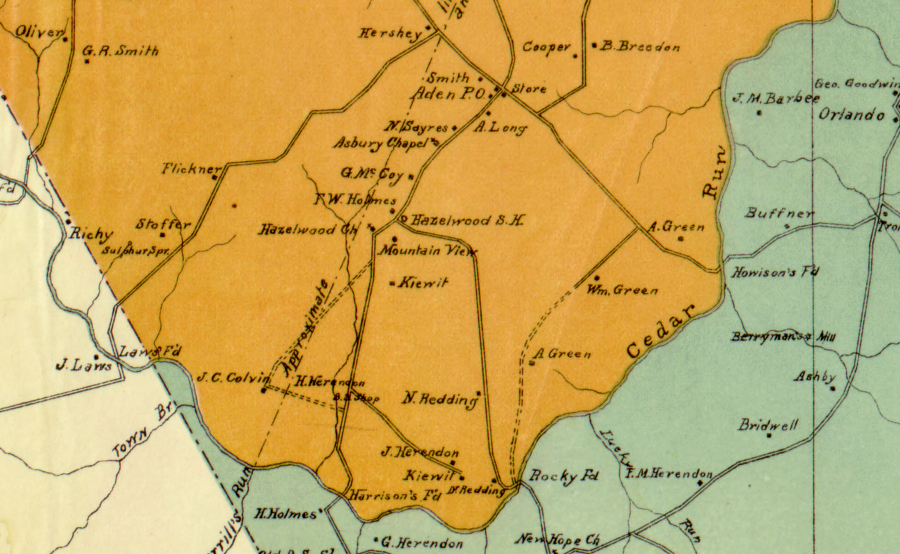
Prince William County in 1901
Source: Library of Congress, area of Merrimac Farm in 1901 (by William H. Brown, 1901)

Prince William County in 1901
Source: Library of Congress, area of Merrimac Farm in 1901 (by William H. Brown, 1901)
Article XI, Section I of the state constitution, adopted at the start of the environmental movement in 1970, says:1
The Federal government manages nearly 2.4 million acres in Virginia as national forests, parks, wildlife refuges, and military bases. The state manages an additional 300,000 acres. That's an impressive total - 4,200 square miles of land. However, Virginia has nearly 40,000 square miles of land, so Federal/state ownership is only 10% of the total. Obviously, government agencies do not own all the ecologically-rich areas in Virginia.2
Land conservation is essential for habitat conservation. Wildlife and plants have evolved in Virginia and adapted to the climate, soils, and other living creature in the web of life within the Mid-Atlantic region. Rapid transformation of the landscape began with the arrival of Native Americans about 20,000 years ago. They hunted the megafauna and assisted in the extinction of species such as mammoths. They transported seeds to new places, and eventually began to clear land and introduce new species for agriculture.
Especially in the Valley and Ridge physiographic province west of the Blue Ridge, Native American use of fire maintained a savanna-like landscape. Human-induced fires disrupted the natural progression towards climax forests and increased habitat diversity.
Europeans who started to arrive in the 1500's had a more dramatic impact on the landscape. A much greater percentage of the forested land was cleared for agriculture in the 1600's and 1700's. The resulting soil erosion altered stream channels and deposited legacy sediments that still impact aquatic habitat in Tidewater rivers and the Chesapeake Bay. In the 1900's, paved roads and urban/suburban development created impervious surfaces that are largely dead spaces for biological activity.
Since the end of the Ice Age 18,000 years ago, natural climate change prevents restoration of the landscape which existed in Virginia before arrival of the first humans. Efforts to conserve natural spaces will never restore the conditions that existed before the first attempt by Europeans to colonize Virginia in 1570.
Even if initiatives to keep 30% of the land in "natural" status are successful, the impacts of transforming the other 70% are irreversible. A human body can not survive if just 30% of the vital organs are saved. Land conservation can be successful in maintaining some native species and natural communities. However, the ecosystems in Virginia will never be as stable or as ecologically diverse as those which existed prior to settlement at Jamestown in 1607.
Private property owners are the primary protectors of Virginia's natural resources. Many organizations work actively to assist private property owners manage their lands to conserve natural resources, while still earn a reasonable rate of return. Extension agents, working closely with the Soil and Water Conservation Districts, assist farmers in minimizing soil erosion.
Some parcels are so significant, historically or ecologically, to justify public invlvement in ensuring the values remain protected over time. Government agencies can purchase private property and incorporate parcels into parks. That requires both funding and public support for the purchase, especially if the landowner does not wish to sell and land condemnation is necessary. Local governments may also express opposition to taking private land off the local tax rolls.
A legal tool called a conservation easement allows for the land to remain in private ownership while ensuring the resource will not be impacted by inappropriate development. A government agency or non-government land trust can acquire rights to protect the historic or ecologically-significant assets, without acquiring the parcel in fee. For example, a conservation easement could prevent conversion of farmland into a housing subdivision, without constraining traditional farming practices on the land and without requiring the farm family to move out of their residence.
According to the National Conservation Easement Database, in 2023 conservation easements held by over 120 organizations protected 1,250,000 acres in Virginia. Over 40% of those easements were held by non-government organizations, including various land trusts. Government agencies held the remaining 60%.3
In a conservation easement, a landowner transfers specific development rights on a parcel to a non-profit land trust or government agency while retaining fee ownership of the property. The landowner can authorize or prohibit public access, limit how many structures may be built, define how timber will (or will not) be harvested and other vegetation will be managed, etc.
After the deed for the conservation easement is filed in the local courthouse, the lawyers working for the land trust have the right to force the landowner to comply with the terms of the easement. Non-government organizations operating as land trusts, such as the Piedmont Environmental Council, must have the capacity to inspect sites for compliance with easement terms. Land trusts must also have the expertise to file suits to force compliance when necessary.
Because conservation easements "run with the land" and affect development rights in perpetuity, the organization responsible for enforcing an easement must also exist in perpetuity. It is common for land trusts to request a stewardship contribution as part of the deal to hold an easement. If an easement is held by a government agency such as the Virginia Outdoors Foundation, that agency must also get adequate funding in perpetuity to oversee the property rights it has acquired.
Conservation easements involve valuable property rights; large easement deals often involve complicated financial planning. After an easement limits development potential on a parcel, it will be assessed at a lower value and local property taxes will lowered. If an easement prevents construction of new houses on a parcel valued primarily for residential use, property taxes could drop over 90%. If a landowner donates all or part of the value of a conservation easement, that donation may qualify for income tax deductions. 4
Landowners can sell or donate conservation easements to ensure land use practices are "environmentally responsible" for decades to come. The easements reduce the development potential of the land, and the lost income from potential development is partially offset by tax advantages. Astute conservation organizations hire financial planners and tax experts as well as ecologists and biologists.
The Land Preservation Tax Credit in Virginia ins one of the most generous in the United States. Landowners who donate property (including conservation easements) are entitled to an income tax credit equal to 40 percent of the market value of the donation. Over 1 million acres, of the 40 million acres in Virginia, have been conserved by the program since it was created in 1999.
In the 25 years between 1999-2024, the General Assembly appropriated $119 million for the Virginia Land Conservation Fund for farmland preservation, forestland conservation, historic area preservation, natural area protection, and open spaces and parks. The Virginia Land Conservation Foundation awarded 356 grants to fund the conservation of 156,694 acres:5
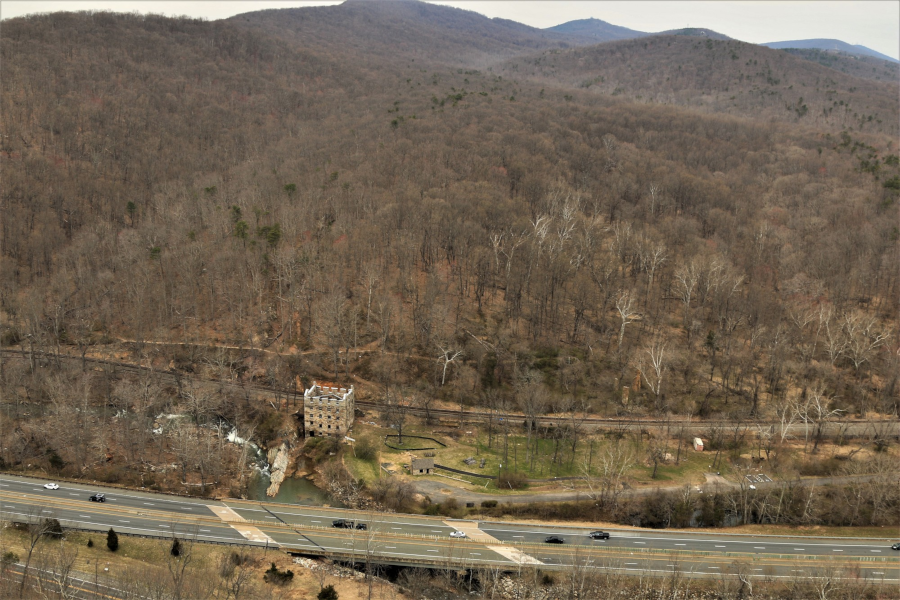
Chapman's Mill at Thoroughfare Gap is privately owned, next to the Bull Run Mountains Natural Area Preserve managed by the Virginia Outdoor Foundation
Source: Historic Prince William, Aerial Photo Survey 2019
The Nature Conservancy is an effective conservation organization in Virginia. It is headquartered in Arlington, right at the Ballston Metro Station. The old Rosslyn office space was unremarkable, but after moving in 1999 The Nature Conservancy established a beautiful little garden of native plants, primarily ferns and cardinal flowers (Lobelia cardinalis) outside the building.
Conservation organizations are more willing than the government organizations to acquire less-than-fee rights in property. Government officials find it difficult to manage land cooperatively while appearing to treat everyone equally, since circumstances on each parcel vary so dramatically. Land trusts, on the other hand, are less subject to public criticism when they accommodate special requirements or subsidize individual landowners. In Southwest Virginia, the Nature Conservancy has financed fences and watering systems so cattle can access drinking water without getting directly in the streams, stirring up sediment and polluting the water.
The most striking example of private conservation effort is the organization's acquisition of the salt marshes along the Atlantic Ocean side of the Eastern Shore. The Virginia Coast Reserve was acquired quietly, and now totals 45,000 acres. The organization has earned trust as well as respect on the Eastern Shore by seeking to create business opportunities in the area, rather than just "lock up" the marshes and keep people from disturbing the wildlife.
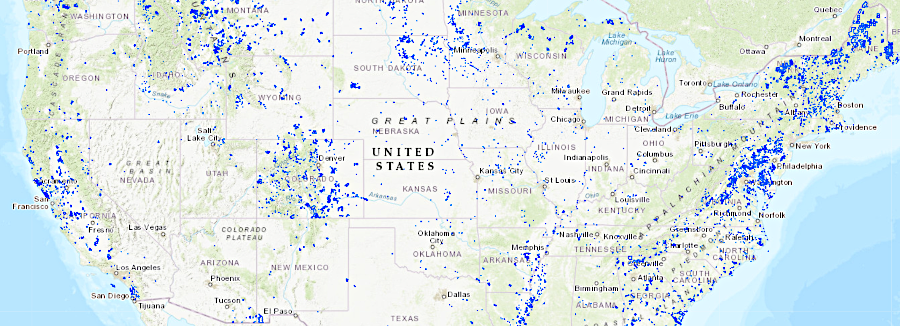
the concentration of conservation easements in Virginia is distinctive, compared to most other states
Source: National Conservation Easement Database
Instead, The Nature Conservancy supports eco-tourism and sponsors sustainable development initiatives in Accomack and Northampton counties through the Virginia Eastern Shore Corporation, established in 1994. The Eastern Shore is heavily dependent upon poultry raising and farming, and the Virginia Eastern Shore Corporation is helping establish the Eastern Shore Select Hayman sweet potato as a high-value item, in part my making potato chips out of potatoes that were not suitable for sale in grocery stores.
The Nature Conservancy calls itself the "real estate arm of the conservation movement," but conservation has a business side too.
The Nature Conservancy is actively trying to protect the mussel species in the Clinch River ecosystem. The organization is trying to steer the Russell county economy away from coal mining and towards sustainable forestry, agriculture, and tourism. If most natural resources remain on private lands, it's essential that natural resource conservationists get involved in the local economy. The Nature Conservancy does not consider business and profit-making activities to be hostile to conservation, or vice-versa. The organization has a long-term perspective to modify standard land use practices in a few selected communities, so they protect (rather than exhaust) the natural areas that tourists might come to see.56
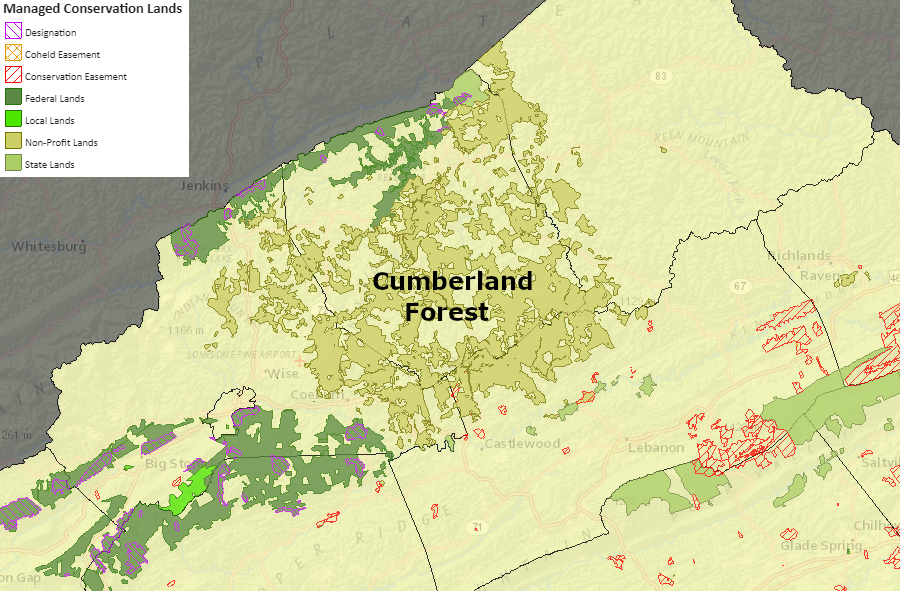
The Nature Conservancy's Cumberland Forest project has protected many acres in Southwestern Virginia, especially Dickinson County
Source: Virginia Department of Conservation and Recreation (DCR), Virginia's Managed Conservation Lands Map
The Cumberland Forest project in Southwest Virginia is one of The Nature Conservancy's largest conservation efforts in the eastern United States, and is advertised as a "Conservation at Scale" initiative. The Highlands unit consists of 153,000 acres within Virginia where surface rights were acquired from a coal company. Several thousand acres of the property were still being mined when the acquisition was announced in 2019, and The Nature Conservancy did not purchase the mineral rights.
In 2023, the Virginia Land Conservation Foundation approved funding purchase of a conservation easement on the 44,327-acre Highlands Lonesome Pine area. The Virginia Department of Forestry had previously acquired a conservation easement protecting 22,858 acres acquired by The Nature Conservancy in Tazewell County.
State purchase of conservation easements helped The Nature Conservancy recover costs the organization had incurred from purchasing the surface rights. That enabled the organization to recycle resources and acquire more land. Land trusts such as The Nature Conservancy can negotiate faster with landowners and with greater flexibility than a state or Federal agency to protect natural areas, but government funding is essential as well as private donations for an acquisition program to be continuously seeking opportunities with landowners.
The Virginia Land Conservation Foundation board's decision in 2023 to purchase an easement for the Highlands Lonesome Pine area occurred with a split 10-2 vote. The foundation had to waive the standard requirement for full fee acquisition. Not acquiring the mineral rights left the risk that coal mining would become economic again. If so, the forest on the surface and other ecological assets being conserved could be stripped away in order to extract the coal.
In addition, the foundation had to waive the standard requirement for a boundary survey. Costs for surveying over 44,000 acres in multiple fragmented parcels were too high. To facilitate the conservation easement, the Office of the Attorney General and the Department of General Services had to accept just a boundary exhibit rather than a full-fledged survey marking the actual edges of all the parcels.7
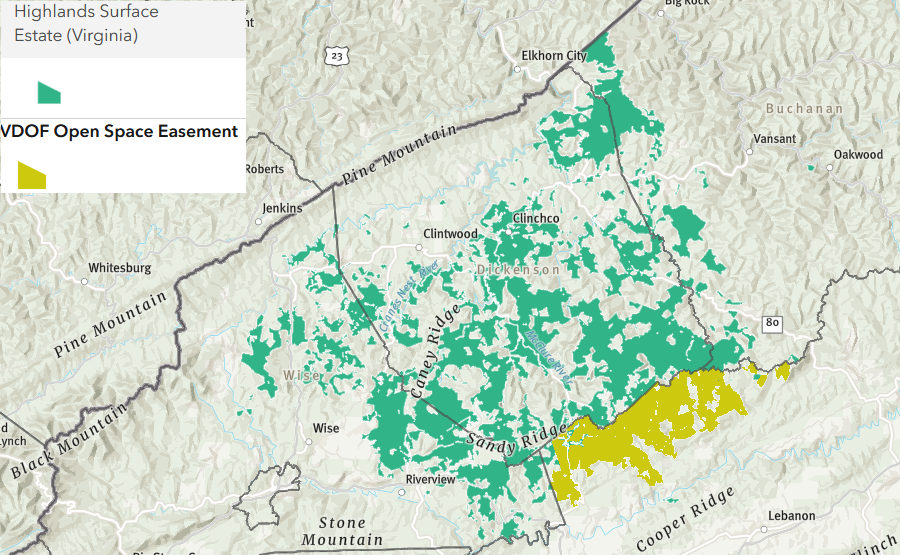
the Virginia Department of Forestry holds a conservation easement on 22,858 acres in Tazewell County
Source: The Nature Conservancy, The Cumberland Forest Project: Conservation at Scale
In 2023, Governor Glenn Youngkin announced the designation of the Potomac and Tidewater Sentinel Landscapes in the Virginia Security Corridor. The Sentinel Landscape program had been created in 2013 by the US Department of Agriculture, Department of Defense, and Department of the Interior to reduce encroachment around military bases, and to acquire development rights so the mission at those bass would not be constrained by landowner complaints.
In addition to limiting the potential for base closures that would disrupt the local economy, the program also served to enhance climate resiliency and conserve natural resources. The governor's news release highlighted:8
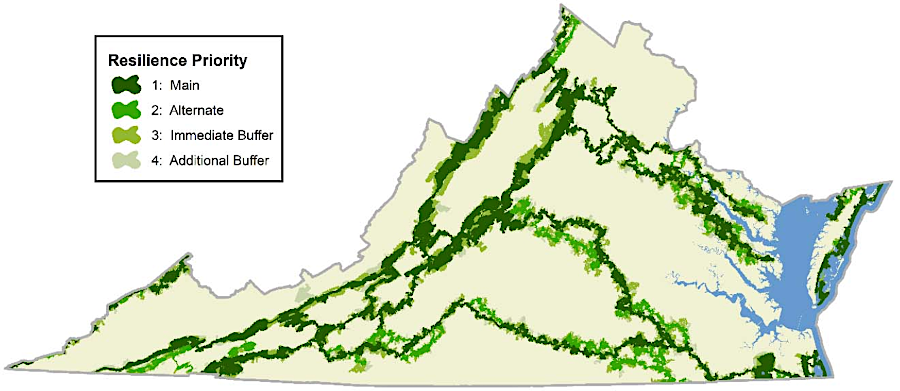
the Wildlife Corridor Action Plan designated Wildlife Biodiversity Resilience Corridors, a priority for maintaining migration opportunities
Source: Virginia Department of Conservation and Recreation (DCR), Virginia Natural Heritage Data Explorer
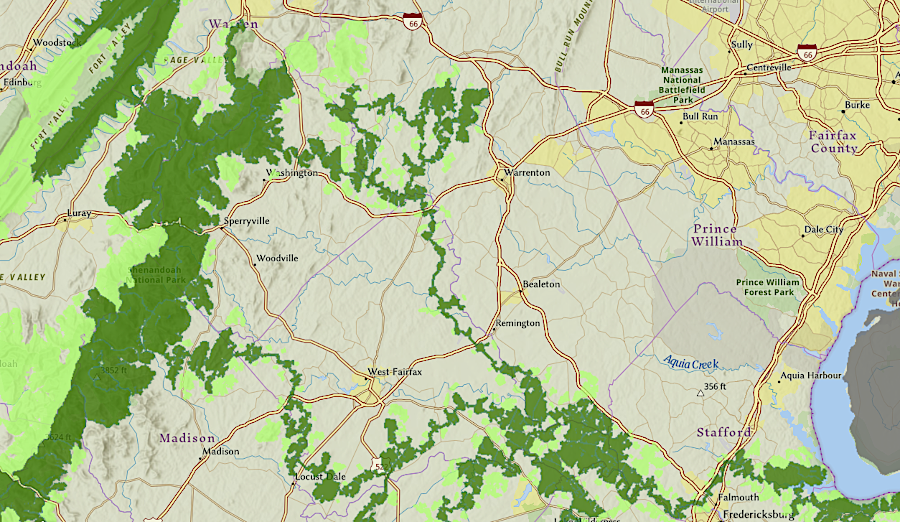
no Wildlife Biodiversity Resilience Corridors were identified in already-developed Northern Virginia
Source: Virginia Department of Conservation and Recreation (DCR), Virginia Natural Heritage Data Explorer
Four state agencies, the Virginia Department of Wildlife Resources, Virginia Department of Conservation and Recreation, Virginia Department of Transportation, and the Virginia Department of Forestry, prepared a Wildlife Corridor Action Plan in 2023. It was designed to make roads safer for people and wildlife, and to identify where wildlife crossings might reduce deer-car collisions in particular.
Through the plan, state agencies identified priorities for land protection, habitat restoration, and wildlife crossings to support wildlife corridor connectivity.9
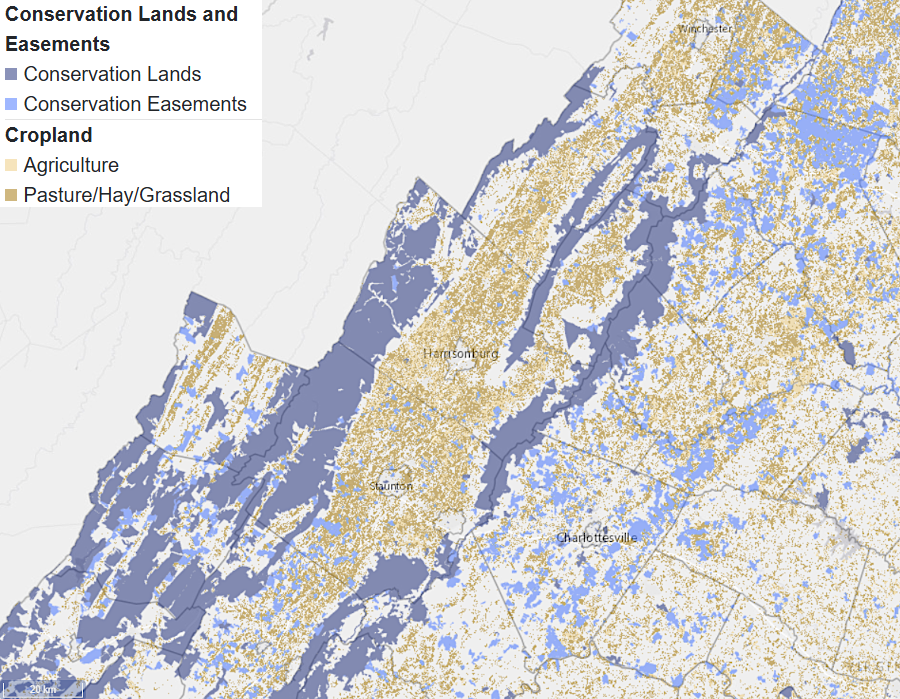
conservation easements are rare in areas with productive cropland, compared to the mountain regions
Source: Virginia Tech, VALEN - Virginia's Land and Enery Navigator
Coastal Virginia Conservancy and the Elizabeth River Project signed the first "rolling easement" in the United States on January 16, 2024. Wetlands Watch helped develop the novel conservation strategy for the site.
The Elizabeth River Project had just completed the 6,500-square-foot Pru and Louis Ryan Resilience Lab next to a tributary of the Lafayette River, Knitting Mill Creek. As sea level rises, that building will be inundated. In 20 years, the location of the Pru and Louis Ryan Resilience Lab is expected to flood annually.
The Elizabeth River Project adopted a short-term strategy of accommodating sea level rise by elevating the first floor 10' above the ground, while adopting a long-term strategy of retreating from the shoreline.
The terms of the rolling easement require the Elizabeth River Project to remove the building and its utility connections when the mean higher high-water average reaches an average over 10 years that is 4.5 feet higher than in 2024. The land will then be transferred to Coastal Virginia Conservancy, which will ensure it stays as a natural wetland.
The example of retreating from rising sea levels stands in contrast to Norfolk's plan to build a seawall around downtown, using "grey infrastructure" to counter sea level rise. The legal implications of the rolling easement are novel.
As water levels change, the shoreline will move inland. The Commonwealth of Virginia claims title to the bottom of rivers and tidewater below the Mean Low Water line, the line of low tide averaged over 20 years. As the shoreline migrates, Virginia's claims migrates.
Also, the 5th Amendment of the US Constitution prohibits government agencies from "taking" private property without fair compensation. The rolling easement eliminates the potential for the landowner to claim in the future, when the City of Norfolk declares the building to be uninhabitable, that a taking has occurred by local or state government. The Elizabeth River Project can not sue for compensation based on the takings clause; it has already sold its rights to the property, when it will be inundated, to the land trust.10
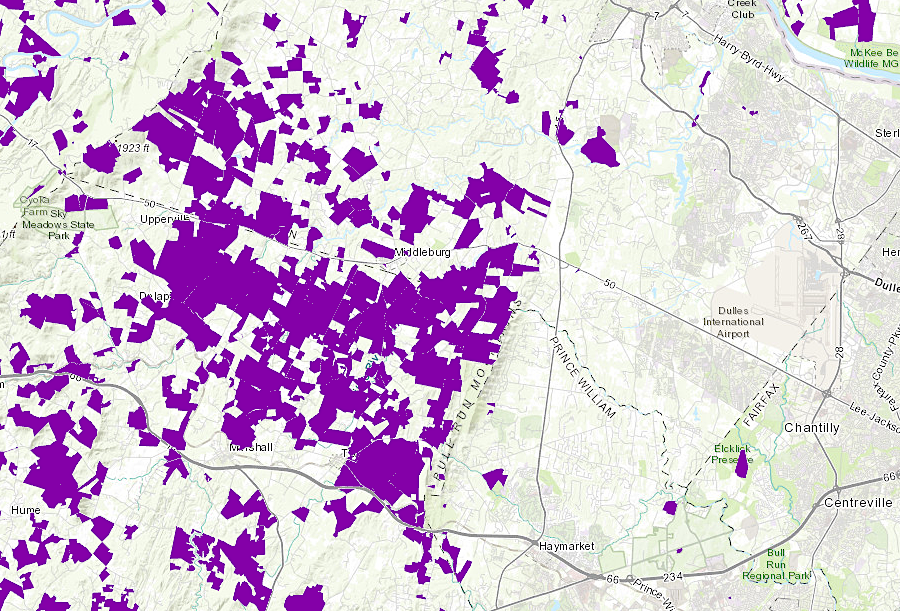
the Piedmont Environmental Council has focused on getting conservation easements in Fauquier and Loudoun counties, not Prince William or Fairfax counties
Source: Conservation Biology Institute, National Conservation Easement Database
Conservation values can be increased for public land that is used primarily for other purposes. The Virginia Department of Transportation (VDOT) established the Pollinator Habitat Program in 2014, and in 2019 joined the Monarch Butterfly Candidate Conservation Agreement with Assurances. By 2024, the Virginia Department of Transportation had established 8,000 acres of pollinator habitat in median strips and on the edges of paved highways. The beautification effort was also cost-effective by reducing the costs of mowing and the use of herbicides to contrl invave species that could reduced driver visiblity.11
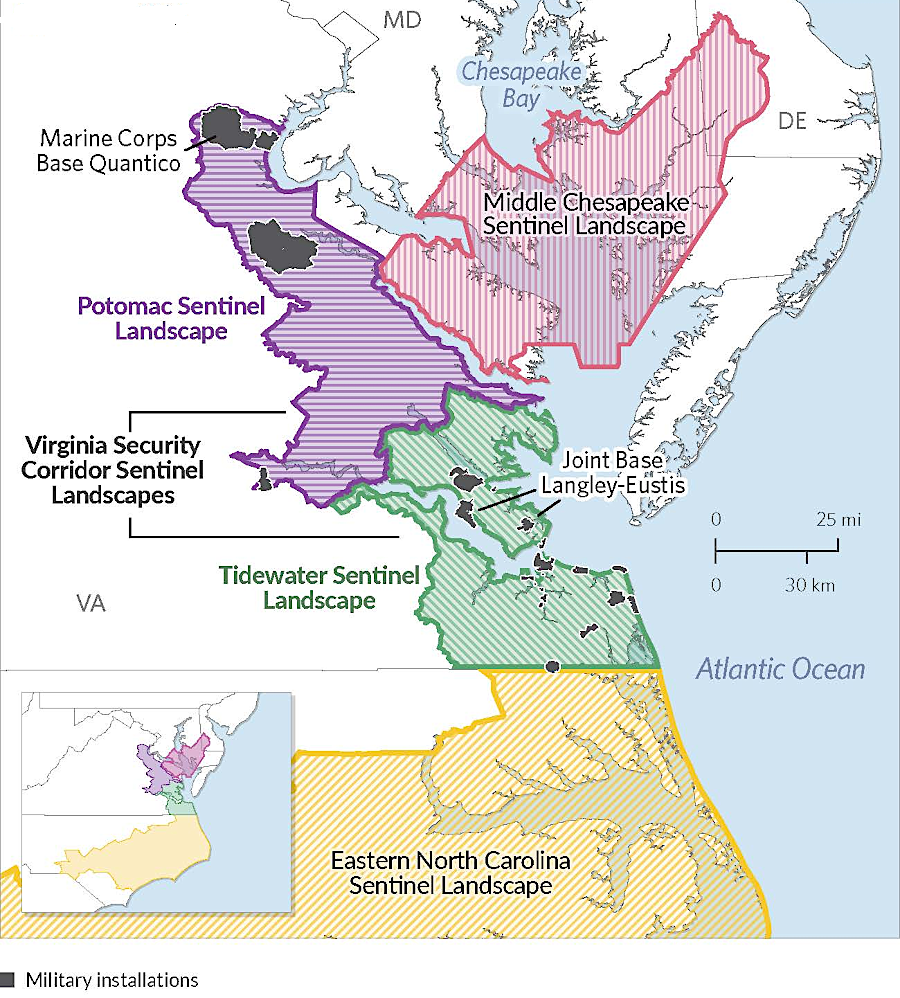
designation of sentinel landscapes was intended to reduce encroachment of inappropriate development next to military bases
Source: Governor of Virginia, Commonwealth of Virginia Announces New Sentinel Landscape Designations (July 10, 2023 news release)
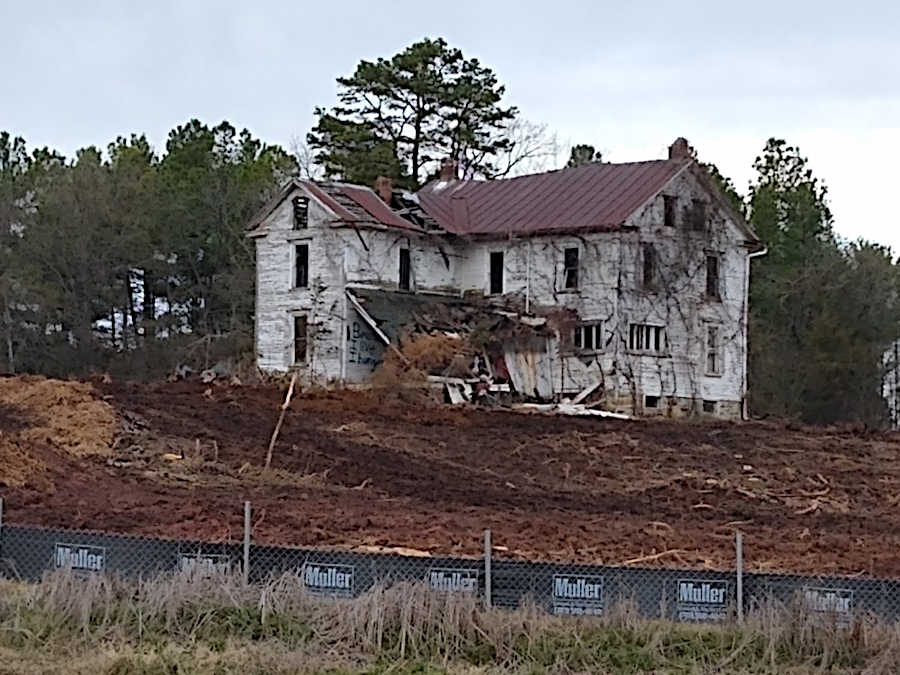
new subdivisions alter cultural as well as human history
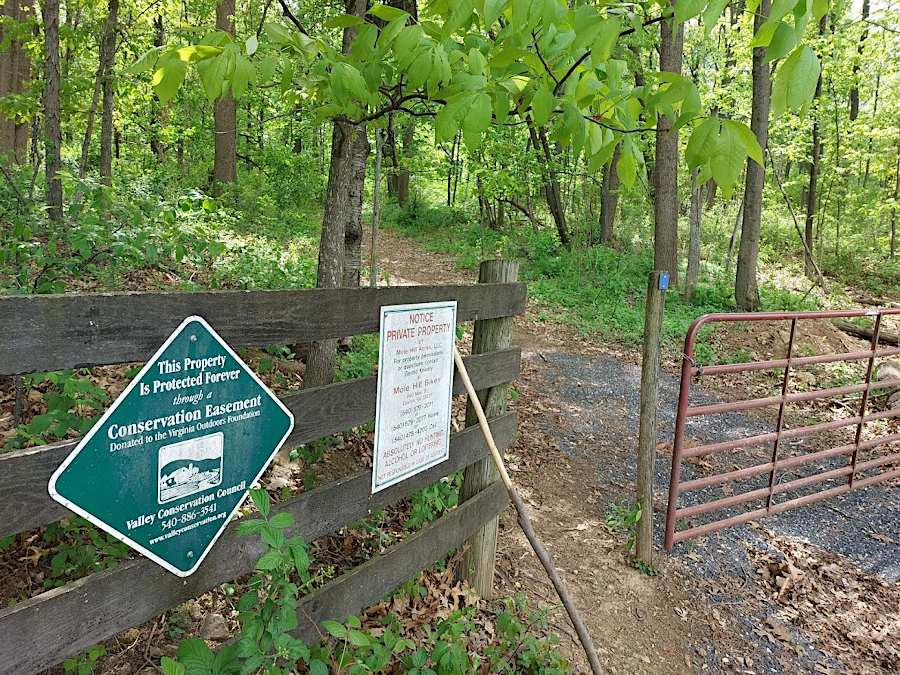
the natural character of Mole Hill, the volcano west of Harrisonburg, is protected by a conservation easement